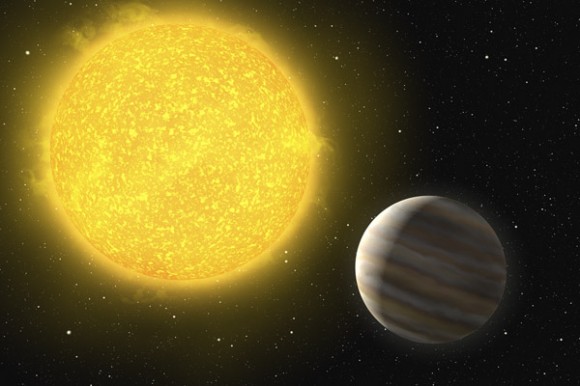[/caption]
Three undergraduate students doing a research project discovered an extrasolar planet. The planet is about five times as massive as Jupiter, not all that big as far as previously detected exoplanets go. This is also the first planet discovered orbiting a fast-rotating hot star. The students, Meta de Hoon, Remco van der Burg, and Francis Vuijsje from Leiden University in the Netherlands, were testing a method of investigating the light fluctuations of thousands of stars in the OGLE database in an automated way. The brightness of one of the stars was found to decrease for two hours every 2.5 days by about one percent. Follow-up observations, taken with ESO’s Very Large Telescope in Chile, confirmed that this phenomenon is caused by a planet passing in front of the star, blocking part of the starlight at regular intervals. “It is exciting not just to find a planet, but to find one as unusual as this one; it turns out to be the first planet discovered around a fast rotating star, and it’s also the hottest star found with a planet,” says Meta. “The computer needed more than a thousand hours to do all the calculations,” continues Remco.
According to Ignas Snellen, supervisor of the research project, the discovery was a complete surprise. “The project was actually meant to teach the students how to develop search algorithms. But they did so well that there was time to test their algorithm on a so far unexplored database. At some point they came into my office and showed me this light curve. I was completely taken aback!”
The planet is given the prosaic name OGLE2-TR-L9b. “But amongst ourselves we call it ReMeFra-1, after Remco, Meta, and myself,” says Francis.

The planet was discovered by looking at the brightness variations of about 15,700 stars, which had been observed by the OGLE survey once or twice per night for about four years between 1997 and 2000. Because the data had been made public, they were a good test case for the students’ algorithm, who showed that for one of stars observed, OGLE-TR-L9, the variations could be due to a transit — the passage of a planet in front of its star. The team then used the GROND instrument on the 2.2 m telescope at ESO’s La Silla Observatory to follow up the observations and find out more about the star and the planet.
“But to make sure it was a planet and not a brown dwarf or a small star that was causing the brightness variations, we needed to resort to spectroscopy, and for this, we were glad we could use ESO’s Very Large Telescope,” says Snellen.
The planet, which is about five times as massive as Jupiter, circles its host star in about 2.5 days. It lies at only three percent of the Earth-Sun distance from its star, making it very hot and much larger than normal planets.
The spectroscopy also showed that the star is pretty hot — almost 7000 degrees, or 1200 degrees hotter than the Sun. It is the hottest star with a planet ever discovered, and it is rotating very fast. The radial velocity method — that was used to discover most extrasolar planets known — is less efficient on stars with these characteristics. “This makes this discovery even more interesting,” concludes Snellen.
Source: ESO


Congratulations, RMF! I hope you are an inspiration to our American students. As a trend, science and engineering education is becoming less popular here.
Great work guys… plz do publish ur algorithms soon….looking forward to it….
“ReMeFra-1”
Something in that name tells me their planet searching days aren’t over. I hope they find others. ;o)
Great job!
That’s definitely something to brag to your classmates about!
Aw man, these scientists look like kids. They’re finding exoplanets and I can’t even find my keys. Thanks for making me feel old.
Joking aside, its a fantastic achievement – hartstikke gefeliciteerd! (With apologies for the ropey Dutch)
Great article and site too.
I hope schools everywhere broadcast this far and wide. Not only for the accomplishment in general, but that two young ladies were involved. Hopefully this will encourage more girls to get into the sciences, that it is not just for geeky boys.
undergrads? they look like eighth graders. makes me feel older than dirt. do they get to name it?
And to think I can’t even find my car keys half of the time. VERY nice work!
great!! boyz this is the same planet xor nt.??
THIS IS SO INTERESTING. I HOPE THEY NAME THE PLANET AFTER YOU. YOU CERTAINLY DESERVE IT.
MAYBE THIS IS ONLY THE BEGINNING OF A CAREER FOR YOU.
CONGRATULATIONS ON YOUR GREAT DISCOVERY.!!
Congrats guys. You deserve the biggest applause. I will use your discovery to induce my kid to science and the like.
And here is another applause from another admirer. Your example is a cheer inspiration. And this flood of the exoplanets’ images of this year is indeed something revolutionary.
CONGRATULATIONS to everyone.
I am sure finding extra-earth life is just a question of time and patience, and the devotion of those working in space research